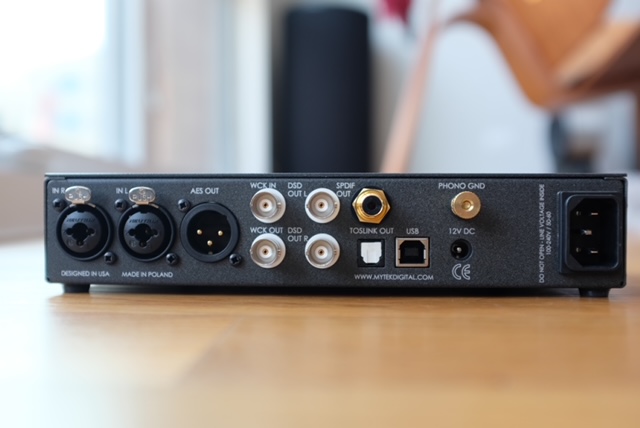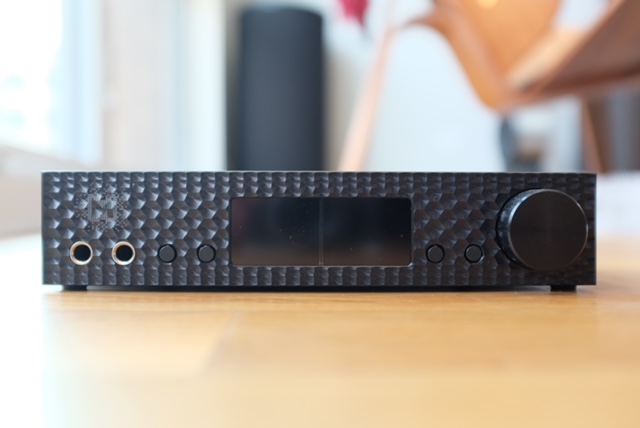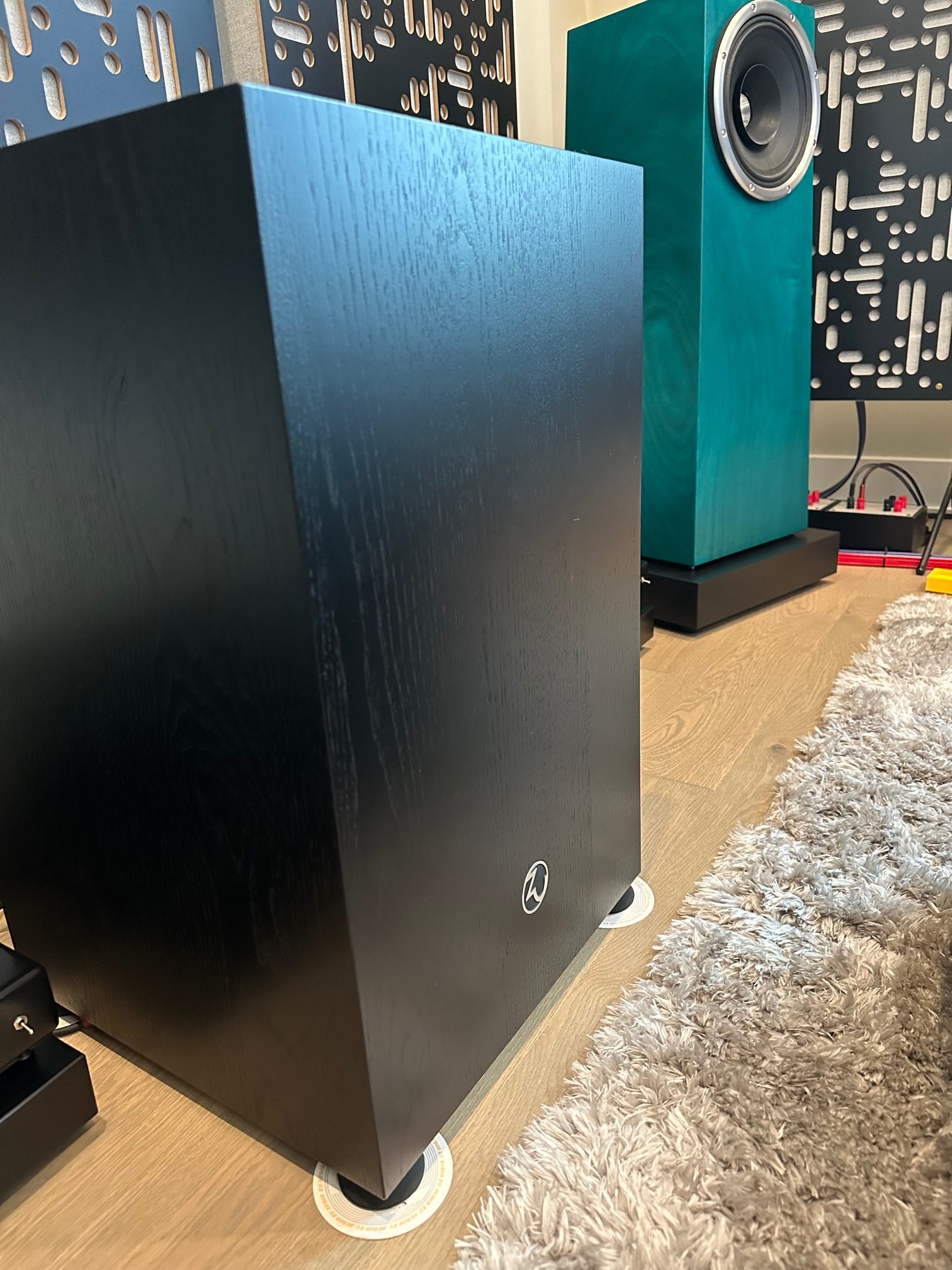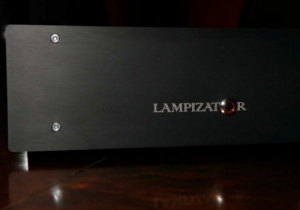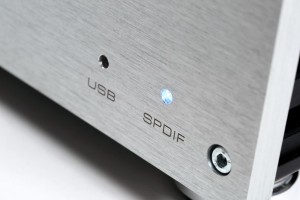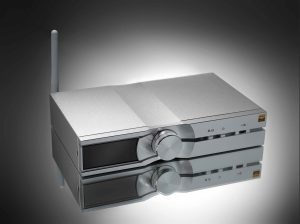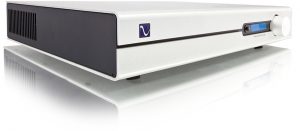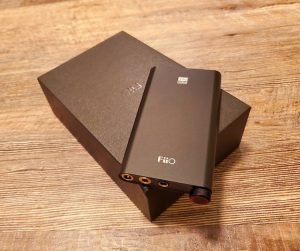Most diehard audiophiles believe the best system you can build will have the following components: a turntable, phono stage/preamp, and an amplifier. Keep it simple, keep it analog, and with the right component selection, the result is a system that sounds effortless and realistic in a way that a digital based system can never sound.
While I will be the first to acknowledge that some of the best systems I have ever heard were built using the above philosophy, those systems traditionally were located in a dedicated room, not just for the speakers and components, but also for the massive record collection that accompanied them. Listening to music on these systems was a production and a lesson in patience; before listening each record was cleaned by a record cleaning machine before being placed on the platter. This was followed by a two minute cycle of brushing the record with an anti static brush before the needle was dropped.
As a younger audiophile who grew up during the CD era, I really only began to appreciate music with the birth of iTunes, the iPod, and Digital Distribution. The idea of building a system optimized around physical media, especially records, was something that I simply could not get my head around. As a result, I have a system centered around a Chord Dave and M Scaler that acts both as a preamp and a DAC. My music is served from a home built Roon Core where my CD rips as well as my Tidal and Qobuz libraries are stored. This created one problem, the Dave became the center of the system and I had no good way to add an analog source. This was not an issue for me, as for the past four years I had lived in an apartment where footfalls created too much of a problem for my Clear Audio Concept, which caused me put my modest record collection in storage up until recently.
While I am not a vinyl purist like many audiophiles out there, I do have an appreciation for vinyl, and have a collection of about 100 records, with an almost even split of pre 1985 originals and new issue vinyl. Over the past year I had a desire to figure out how to listen to these records again, and after some research and consulting with a few friends and manufacturers, I ended up purchasing a VPI Classic Signature table and Whest Audio 40RDT phono stage to help me re-enter the vinyl world. The hope was that pure mass would be enough to counteract the footfall problem in my apartment. After getting it setup, along with some additional dampening applied to the equipment rack, I was able to walk freely within the apartment with no footfalls. This led me to a new problem, now that I had the record player, how was I going to pipe it into my system? I could swap interconnects every time I wanted to listen, but I know myself and that would mean I would never use the brand new VPI table.
As I mulled whether to add a dedicated preamp to my system, I was forced to consider two things. The first question was did I think my digital signal chain sounded "digital?" As I thought about it, I concluded that I did not believe it did. While I enjoyed my vinyl playback when the phono preamp was directly connected to the ampsandsound Nautilus, I did not get the sense that my DAC would not be capable of reproducing the nuances of the analog system if it was fed with a high quality digital stream. The second question was around value. A preamp that can better the Dave's built in digital volume control is not cheap, and if the only value that adding a preamp into my system would provide is allow me to switch between my Dave and VPI, then I personally did not think it was worth it.
Answering these two questions led me to begin to explore the world of analogue to digital converters (ADC). With an ADC I could convert the output of the phono pre and route it into the Chord Dave/M Scaler. Now this was not my first foray into analog to digital converters, I have a PS Audio NuWave Phono Converter, and have spent quite a bit of time with the Lynx Hilo Studio, but was never quite satisfied with either of them for live listening. The trip from the ADC to the DAC seemed to take away the magic of vinyl. At first I thought this was just an intrinsic problem, but after listening to products like the Sugar Cube, and thinking more about how modern music is mastered today, I decided it was worth exploring ADCs again. This lead me to the Mytek Brooklyn ADC.
The Mytek Brooklyn ADC
Mytek is a well respected brand in the audiophile community, but they are equally respected in the pro-audio and mastering community. This is what attracted me to the Mytek Brooklyn ADC, if studios were using this as an ADC during their mastering process, then it was highly likely that the Brooklyn ADC was accurate and incredibly quiet. However, the selling point for me came down to the specifications with the stand outs being a noise floor below -130dB, the ability to capture PCM at a sample rate of up to 384kHz, DSD up to DSD 256, and the ability to capture up to 32 bits over USB. I also especially appreciated that the Brooklyn ADC had both Coaxial Digital out and AES digital out.
When the Mytek Brooklyn ADC arrived, I was greeted by the beautiful yet simple Mytek aesthetic. My Brooklyn ADC is black, but it is also available in silver. The front of the device is quite sparse, it has two ¼ mono inputs, four small black buttons, a screen, and a rotary knob. The buttons and rotary knob control the screen, and while it took a few minutes to figure out how to navigate, the result was simple and intuitive. The screen itself is bright and beautiful, it is easily once of the nicer displays that I have seen on an audio device with the only real rivals being NADs M10 and AURALiC's Aries G1.
Turning the Brooklyn ADC around, you are greeted by balanced analog in (which can also be used with single ended ¼ inch inputs, and a single ended to balanced adapter), world clock in and out, AES out, optical out, USB Out, coaxial out, 12 volt DC in (for an external power supply) and the IEC power connector. The Brooklyn ADC was built for studio use, and to be paired with a Brooklyn DAC side by side in a rack, so the ADC is a half width component which makes its placement in the audio rack a bit easier.
Before setting up the Brooklyn ADC, I connected it to my computer and downloaded Mytek's drivers and control software. Once installed, I upgraded the firmware to the latest version, and checked to make sure everything was working as expected.
For the majority of this review, I used the ADC in standalone mode. This is the mode where the ADC is not connected to a computer, it performs its analog to digital conversion, and outputs the results on all of its digital outputs. This was the easiest way for me to use the ADC given my primary use case was live vinyl playback. I did connect the ADC to my computer as well, and I will talk about the Brooklyn ADC in that context later in this review. To summarize, the common trait of the Brooklyn ADC was transparency, no matter how it was used, in my subjective listening tests I could not discern a difference listening to my analog front end through the Brooklyn ADC/Dave combo vs just the vinyl front end alone. This alone makes the Brooklyn ADC worth its cost.
Looking Closer at the Brooklyn ADCs More Advanced Features
If you are an audiophile planning to buy the Brooklyn ADC, you will likely not use many of its more advanced features. This is the case for me, I feed the ADC from the balanced outputs of Whest Audio 40RDT, I leave the ADCs input mode set to balanced, and for most of the review I ran the ADC at a sampling rate of either 192kHz or 384kHz. My guess is most audiophiles will likely follow the same path and be very happy.
For studio or other more unique use cases, the Brooklyn ADC has a few more tricks up its sleeve. As long as you are feeding the Brooklyn ADC with balanced analog audio, you can engage transformers on the analog input. These are high quality nickel core transformers. In the mastering world, these are used to step down and compress the incoming signal, especially useful when working with hotter sources and trying to get tone / texture right when recording instruments. There are three different transformer options, which select different ratios on the transforms winding, 3:1, 2:1, and 1:1. I found that 3:1 was a nice setting for thinner sounding recordings, but for the most part found myself not engaging the transformers. I found a bit more detail without the transformers in the circuit. This also makes sense because this feature was not meant for home use but instead for studio use.
Sample rate options are abundant with every PCM sample rate from 44.1kHz to 384kHz possible, as well as DSD 64 - DSD 256. This is one of the things that makes the Brooklyn ADC special. Most ADCs manuals specifically advise that you should not choose the highest sample rate, and instead operate the ADC at half the maximum sample rate. The reason for this is that at higher sample rates most ADCs, have a substantial increase in the out of band high frequency noise floor. Depending on your system's ability to produce high frequency noise, and your ear's ability to hear it, this high frequency noise can lead to what most would call "digital glare." This is where Mytek's Brooklyn shines, its out of band high frequency noise floor is ruler flare all the way out to 200,000Hz even at its highest sample rate settings. This allows the Brooklyn ADC to be run at its maximum sample rates without introducing audible or noticeable high frequency noise and the result is really something to behold. According to Mytek, the Brooklyn ADC is likely the only ADC available commercially today that has this characteristic. While I cannot say for certain if that is true, you can hear the difference compared to lesser ADCs like the PS Audio NuWave Phono Converter.
The above point though is one of the reason that mastering and archival companies have been major purchasers of the Brooklyn ADCs. One of the applications that only the Mytek Brooklyn ADC is capable of, because of its flat -140dB noise floor all the way to 200kHz, is the sophisticated "Plangent" process where digitized tape machine bias is used to remove "wow and flutter" from the recording, which dramatically affects timing cues and thus the soundstage. Up until the Brooklyn ADC was created, it was not really possible to capture this biasing track using an ADC, as the high frequency noise introduced by the ADC would obfuscate the biasing track. This is not the case with the Brooklyn. Analog tapes suffer from wow and flutter, where the tape gets stretched and pulled because analog tapes are analog, they depend on time and speed to convey their data correctly. This is why stretching a tape will have an impact on the final sound quality. However, if you can capture the biasing track during archival, you can detect the wow and flutter based on the deformation of the biasing tracks sine wave. Once you detect the deformities, you can fix them, and whatever correction is applied to the biasing tracks sine wave, can then be applied to the audio tracks which will correct the errors introduced by the wow and flutter of the tape during archival. While I have not had an opportunity to listen to a tape that has been archived using this technique, Mytek's owner Michal told me that the result is a rock solid 3D image. I believe this is probably true, as I have found DACs that prioritize timing accuracy (like Chord DACs) to produce the best and most stable 3D images. Research conducted into psychoacoustic also suggest that humans are very sensitive to timing errors and phase shifts in audio.
The other thing I wanted to note about the Brooklyn ADC, is that its display is incredibly helpful during setup. The analog meters allowed me to quickly identify a slight ground loop, determine the cause (by pulling things until the analog meters noise reading dropped), and then provided a visual cue that my fix worked.
The Review System
For this review the following system was used, all items were fully broken in for at least 100 hours before critical listening occurred.
- Turntable: VPI Classic Signature, Fatboy Gimbal Arm
- Cartridge: Audio Technica OC9XSL
- Phono Stage: Whest Audio 40RDT
- ADC: Mytek Brooklyn ADC
- DAC: Chord Dave, Chord M Scaler
- Amp: ampsandsound Nautilus
- Headphones: Hifiman Susvara
- Power: PS Audio P12, SBooster
- Cabling: Wywires Platinum Interconnects and headphone cable, Wywires Platinum Juice II Power cords
The Mytek Brooklyn ADC was always connected to the Whest Audio Phono stage using balanced interconnects, and the ADC was connected to the Dave/M Scaler using AES/BNC.
Listening to the Brooklyn ADC
I started my review using the built in power supply of the Brooklyn ADC. Once I got everything configured, I initially had the ADC set to a sample rate 384kHz, as the Chord equipment supported that on the BNC inputs. While this was mostly stable, I did have a few cases of drop outs, which was not surprising. The BNC spec does not technically support such high sample rates. While I cannot say if the issue was due to the Chord, Mytek, or the cables, I ended up running the ADC at a sample rate of 192kHz which was rock stable. I also did not easily detect a substantial difference between the 384kHz and the 192kHz on the Brooklyn ADC. While a difference did exist, it was not worth the rare but random drop outs.
Once everything was set up, I dropped the needle and was presented with the sound that I had come to expect from my analog front end. This is incredibly impressive, because now my analog front end was going through an A to D and then a D to A loop. Listening closely, I could not hear any digital glare or high frequency noise. Spatial cues were as expected, and of course a few random pops or clicks came through as you would expect with any analog system. For all intents and purposes it seemed as if I simply directly connected my phono stage to the Nautilus, and for me that meant the Brooklyn ADC achieved its goals.
After giving the ADC three weeks of use, I sat down and began to listen more critically as I prepared to write this review. I found the Brooklyn ADC to really not have a particular sound to it, which from my point of view is a good thing. If I dropped the needle on Meatloaf's Bat Out of Hell, I was presented with a non-stop rock ballad. If I dropped the needle on Yes's Fragile, I was presented with a never ending jam session. Finally, if I dropped the needle on my original, only played by me, copy of the Who's Quadrophenia I was transported to a rock opera that sounded better then any digital remaster or rendition of this album I have ever heard.
To try and check if the ADC was coloring my experience, I would listen to one side of a record with the ADC, and then replay the same side of the record, with the Whest going directly to the Nautilus. While this is not the best way to A/B, as audio memory is fickle, I was not able to hear a difference between the two renditions. I tried this multiple times throughout my time with the Brooklyn ADC, and always expected to hear something that told me the ADC was in the circuit, but no matter how hard I tried, I simply could not find anything that I could pin point and say "that is the ADC." Dynamics, tone, tempo, and timbre were all equivalent with or without it in the circuit.
One of the things I really like about this ADC is that it does not require a computer. While most will probably connect this ADC to a computer in order to archive their vinyl or tape collection, I really wanted something that could stand alone for live playback and in this respect the Brooklyn ADC really delivered.
Using the Brooklyn ADC for archiving and streaming
Whenever I have to connect a piece of audio equipment to a computer, I tend to hold my breath and wait for it to be recognized. The reality is that most audio companies are not software companies, and I have had my fair share of incompatibilities, driver issues, and "this was not done right" experiences with audio equipment that gets plugged into a computer. That is not the case with Mytek.
As I said in the beginning of this review, Mytek has its roots in the pro-audio world. As a result of how their products are used, and who uses them, their software is exceptional, and I did not run into a single issue with either my Windows or Mac computers. Mytek's control panel software is not the prettiest, but it works well and is simple to use. Their drivers also proved to be stable on Windows, and I was able to set up the Brooklyn ADC for vinyl archiving, and live network streaming.
For vinyl archiving, I was able to record both DXD and DSD 256. Playing back the archives via my Roon server to the Chord Dave worked wonderfully. For DXD playback I did not notice much of a difference between live listening and playing back the archive. For DSD, I will say it is an honest treat. Most things I have read suggest the Dave is really designed for PCM playback, but when engaging the Dave's DSD mode, and feeding it the DSD 256 archive, I was greeted with an experience that was simply better than the PCM counterpart, and a bit more organic. Stepping down to DSD 128 lost some of the magic, but the organic nature that I think most associate with DSD came through on the archives captured with the Brooklyn ADC. To capture my DSD recordings, I used Playback Designs' simple recording software, it worked well, and was easy to use.
Being a Roon user, I have many Roon endpoints throughout my home, some are control ceiling speakers and some are Sonos Speakers. I also have an endpoint in my home theater system. There have been many occasions where I want to drop the needle, and enjoy the record throughout my home. To achieve this I was able to setup an icecast server on my computer, to create the equivalent of an internet radio station and I feed that station with 192/24 PCM directly from the Brooklyn ADC. Once I had that set up, I simply connected Roon to the radio station and was able to stream my analog system anywhere throughout my home. The quality was still exceptional, I am not going to claim that it sounded as good as going directly ADC, but I doubt that I could easily A/B between the two.
Concluding thoughts on the Brooklyn ADC
As I sit back and listen to Quadrophenia, I am left in awe with the transparency of the Brooklyn ADC. I have no urge to pull it out of the signal chain, no need to swap cables and compare, it simply sounds like a direct analog connection. Now to be clear, this was achieved with a world class DAC and up-sampler, but with the Dave, M Scaler, and Brooklyn ADC I no longer have a need for an analog preamp. For me that means this product saved me thousands of dollars, and I will tell you I think it is one of the biggest bargains I have come across. It is built incredibly well, and does exactly what it is supposed to do with no questions asked. It is built by a company that understands the digital domain, and is trying to built the best product that can build irrelevant of the cost, it just so happens that it is also affordable and attainable.
Should you add an extra $400 to the price tag to buy an SBooster or another external power supply? You can, but it is not necessary. However, there is a difference but it is small, and I would suggest listening to the Brooklyn ADC on its own before deciding if it needs an external power supply.
It is rare a product comes along that has pretty much no flaws, but the Brooklyn ADC, for my use, is one of those products. It is versatile, it is priced right, and it performed well above my expectations. If you're an audiophile who takes vinyl archiving seriously, or wants to get analog into a digital system, this is the product for you, and carries my highest recommendation.
Brooklyn ADC
Retail: $1995
Production: This is now a legacy product but can be still purchased (when the review began it was not a legacy product).
Mytek Audio
347.384.2687
To get to the ADC: https://mytek.audio/legacy-products





